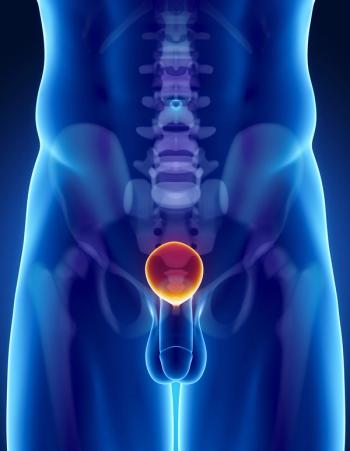
Lenvatinib-Based Regimen Does Not Significantly Improve OS in Advanced ESCC
Meta: Safety outcomes, including the treatment-related AEs and AEs leading to treatment discontinuation, were consistent with or without lenvatinib in ESCC.
The addition of lenvatinib (Lenvima) to pembrolizumab (Keytruda) and chemotherapy did not exhibit a significant improvement in overall survival (OS) vs pembrolizumab plus chemotherapy alone as a first-line treatment in patients with metastatic esophageal squamous cell carcinoma (ESCC), according to phase 3 LEAP-014 trial (NCT04949256) findings presented at the
The median OS in the lenvatinib arm was 17.6 months (95% CI, 15.5-19.1) vs 15.5 months (95% CI, 13.5-17.2) in the chemoimmunotherapy arm (HR, 0.92; 95% CI, 0.77-1.10; P = .1852). The 12- and 24-month OS rates were 65% and 34% in the investigational arm vs 61% and 32% in the control arm, respectively.
In patients with a PD-L1 combined positive score (CPS) of at least 10, the median OS was 18.0 months (95% CI, 16.4-20.4) in the lenvatinib arm vs 15.8 months (95% CI, 13.1-17.4) in the control arm (HR, 0.89; 95% CI, 0.71-1.11). The 12- and 24-month OS rates were 67% and 36% in the investigational arm vs 63% and 31% in the control arm, respectively.
“Lenvatinib plus pembrolizumab and chemotherapy did not significantly improve OS as first-line treatment for [patients with] metastatic ESCC vs pembrolizumab plus chemotherapy,” lead study author Jong-Mu Sun, MD, PhD, of the Division of Hematology-Oncology, Department of Medicine, Samsung Medical Center, Sungkyunkwan University School of Medicine in Seoul, Republic of Korea, stated during the presentation.
What Are the Key Components of the LEAP-014 Trial?
The LEAP-014 trial enrolled patients who were at least 18 years of age with histologically and/or cytologically confirmed locally advanced, unresectable or metastatic ESCC.2 Prior treatment, an ECOG performance status of 2 or higher, and lack of measurable disease per RECIST 1.1 criteria excluded patients from enrollment.
A total of approximately 850 patients were randomly assigned 1:1 to treatment.1 In the investigational arm, patients received 8 mg of oral lenvatinib once daily, plus 400 mg of intravenous (IV) pembrolizumab every 6 weeks, and either cisplatin plus 5-flourouracil (FP) or paclitaxel plus cisplatin (TP) every 3 weeks, or modified FOLFOX6 (mFOLFOX6) every 2 weeks. This was followed by 20 mg of lenvatinib plus 400 mg of pembrolizumab every 6 weeks until progression, unacceptable toxicity, or withdrawal. In the control arm, patients received 400 mg of IV pembrolizumab every 6 weeks plus FP or TP every 3 weeks or mFOLFOX6 every 2 weeks in accordance with local standards.
OS served as the primary end point. Secondary end points included progression-free survival (PFS), objective response rate (ORR), duration of response (DOR) by blinded independent central review, and safety.
A total of 850 patients were randomly assigned to the investigational (n = 423) and control (n = 427) arms: 421 and 426 of whom were treated in the respective arms. In the investigational arm, 2 patients completed treatment and 93 patients remained on therapy. Reasons for discontinuation included progressive disease (n = 206), adverse effects (AEs; n = 72), clinical progression (n = 25), patient decision (n = 18), physician decision (n = 3), and protocol violation (n = 2). In the control arm, 23 patients completed treatment and 70 patients remained on therapy. Reasons for discontinuation included progressive disease (n = 202), AEs (n = 73), clinical progression (n = 22), patient decision (n = 25), physician decision (n = 10), and follow-up loss (n = 1).
Baseline characteristics were well balanced between the treatment groups, Sun said. Within the investigational arm, the median age was 64 (range, 27-86); 49% were above the age of 65. Most patients were male (78%), Asian (66%), and from East Asia (66%). ECOG performance status was 1 in 64% of cases, and most patients had a PD-L1 CPS of 10 or greater (66%). Ninety-nine percent of patients did not have brain metastases and had stage IVB disease. The preferred choice of chemotherapy was mFOLFOX6 (65%), followed by FP (24%) and TP (10%).
Per the study design, efficacy was evaluated in all randomized patients, whereas safety was limited to all randomized patients who received at least 1 dose of study therapy. Of note, PFS and ORR were not tested for statistically significance since OS was not positive. The data cutoff for the present analysis was May 8, 2025, at which point approximately 482 OS events had occurred, or 42 months had passed since the first participant had been randomized.
What Additional Efficacy Data Were Presented?
Sun stated that the OS results were consistent across the prespecified subgroups, including PD-L1 status (CPS ≥10 vs CPS <10), Region (East Asia vs North America and Western Europe vs rest of the world), and chemotherapy (FP vs TP vs mFOLFOX).
Additional results indicated that the median PFS in all randomized patients was 7.2 months (95% CI, 6.8-8.4) in the lenvatinib arm vs 6.9 months (95% CI, 5.8-7.0) in the control arm (HR, 0.89; 95% CI, 0.75-1.04). The 12- and 24-month PFS rates were 31% and 12% in the investigational arm vs 23% and 15% in the control arm, respectively.
The median PFS in patients with a PD-L1 CPS of at least 10 was 8.1 months (95% CI, 6.9-9.5) in the lenvatinib arm vs 6.9 months (95% CI, 6.3-7.2) in the control arm (HR, 0.85; 95% CI, 0.69-1.04). The 12- and 24-month PFS rates were 36% and 16% in the investigational arm vs 25% and 14% in the control arm, respectively.
With respect to response, the ORR was 62.2% (95% CI, 57.4%-66.8%) in the lenvatinib arm vs 54.8% (95% CI, 49.9%-59.6%) in the chemoimmunotherapy arm (delta, 7.3%; 95% CI, 0.7%-13.8%). In the lenvatinib arm, best responses included complete response (CR; 16.3%), stable disease (SD; 22.0%), and progressive disease (PD; 8.0%); 7.3% of patients were not evaluable (NE). In the control arm, best responses included CR (19.2%), PR (35.6%), SD (29.7%), and PD (8.9%); 5.4% of patients were NE.
The median DOR was 8.1 months (range, 1.2+ to 38.7+) in the lenvatinib arm and 17% of patients experienced a response lasting 24 months or greater. In the control arm, the median DOR was 6.8 months (range, 1.2+ to 36.4+) and 21% of patients experienced a response lasting at least 24 months.
What Were the Key Safety Data That Were Presented?
The median duration of treatment exposure was 7.1 months (range, 0.03-41.9) in the lenvatinib arm vs 5.6 months (range, 0.03-28.8) in the control arm. In the investigational arm, any-grade AEs occurred in 99.5% of patients (grade ≥3, 81.2%; grade 5, 9.7%). AEs leading to drug discontinuation occurred in 33.3% of patients. Treatment-related AEs (TRAEs) occurred in 97.1% of patients.
In the control arm, any-grade AEs occurred in 99.3% of patients (grade ≥3, 79.1%; grade 5, 11.5%). AEs leading to drug discontinuation occurred in 39.0% of patients. TRAEs occurred in 96.5% of patients.
AEs that occurred in at least 15% of patients in either arm in order of frequency were decreased neutrophil count, nausea, hypertension, diarrhea, decreased platelet count, anemia, hypothyroidism, stomatitis, decreased white blood cell count, fatigue, decreased appetite, palmar plantar erythrodysesthesia syndrome, proteinuria, aspartate aminotransferase increase, vomiting, rash, weight decrease, constipation, alanine aminotransferase increase, pyrexia, increased lipase, increased amylase, peripheral neuropathy, hypoalbuminemia, and pneumonia.
Immune-mediated AEs and infusion reactions in the experimental arm included adrenal insufficiency (any grade, 4.8%; grade ≥3, 1.4%), colitis (any grade, 1.7%; grade ≥3, 0.9%), encephalitis (any grade, 0.2%; grade ≥3, 0.2%), gastritis (any grade, 2.9%; grade ≥3, 0.2%), hepatitis (any grade, 1.2%; grade ≥3, 0.7%), hyperthyroidism (any grade, 8.1%; grade ≥3, 0%), hypophysitis (any grade, 2.1%; grade ≥3, 0.7%), hypothyroidism (any grade, 33.5%; grade ≥3, 0%), infusion reactions (any grade, 2.1%; grade ≥3, 0.5%), myocarditis (any grade, 0%; grade ≥3, 0%), myositis (any grade, 0.2%; grade ≥3, 0%), nephritis (any grade, 0%; grade ≥3, 0%), pancreatitis (any grade, 0.5%; grade ≥3, 0.5%), pneumonitis (any grade, 7.6%; grade ≥3, 2.6%), severe skin reactions (any grade, 1.9%; grade ≥3, 1.4%), thyroiditis (any grade, 0.7%; grade ≥3, 0%), type 1 diabetes mellitus (any grade, 0.5%; grade ≥3, 0.2%), and vasculitis (any grade, 0.7%; grade ≥3, 0.2%).
“Safety profiles were generally consistent with the known safety profiles of lenvatinib in combination with pembrolizumab and chemotherapy or the pembrolizumab plus chemotherapy regimen,” Sun concluded.
Disclosures: Sun reported financial interests, institutional, and research funding from MSD, Yuhan, AstraZeneca, Ono, and Pfizer.
References
- Sun JM, Kim SB, Ogata T, et al. Lenvatinib plus pembrolizumab and chemotherapy vs pembrolizumab and chemotherapy in untreated metastatic esophageal squamous cell carcinoma: the randomized phase III LEAP-014 study. Presented at: 2025 ESMO Congress; October 17-21, 2025; Berlin, Germany. Abstract LBA79.
- Efficacy and safety of pembrolizumab (MK-3475) plus lenvatinib (E7080/MK-7902) plus chemotherapy in participants with metastatic esophageal carcinoma (MK-7902-014/E7080-G000-320/LEAP-014). Clinicaltrials.gov. Updated August 22, 2025. Accessed October 17, 2025. https://clinicaltrials.gov/study/NCT04949256
Newsletter
Stay up to date on recent advances in the multidisciplinary approach to cancer.


















































































